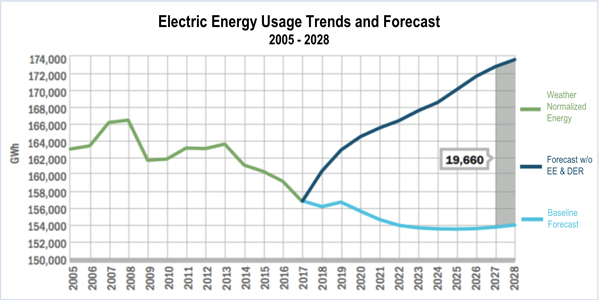By Michael Kuser
New York faces increasing penetration of intermittent distributed energy resources, declining load, all-time low energy prices and the need to replace aging generation as the state moves toward achieving its Clean Energy Standard goal of producing 50% of its electricity from renewables by 2030, according to a NYISO report.
“Compared to other regions in the U.S., New York enjoys a fairly diverse fuel mix, but we’ve identified a real disparity between the upstate and downstate regions … with upstate [being] where just about all the hydro and renewable resources are located,” NYISO Executive Vice President Richard Dewey said Thursday while presenting Power Trends 2018, an annual report covering how technology, economics and public policy are influencing the state’s wholesale electricity markets.
The state’s imbalance of renewable energy supplies means the downstate region (consisting of the Hudson River Valley and New York City area) will become increasingly reliant on natural gas-fired generation, the report said.
Low Capacity Factors
The operational challenge for the ISO is to keep the lights on 100% of the time when the capacity factors for onshore wind and solar are just 26% and 14%, respectively — compared to 89% for nuclear, Dewey said.
“We need to think about having the right type of generation capacity available so that we can meet the load requirement at the grid and provide the right kind of incentives so that generators are available,” he said.
Offshore wind differs from onshore in that it gives higher output during the daytime hours, which is more consistent with New York’s load profile. Offshore wind also operates at a higher capacity factor, sometimes in the 40% range or higher, Dewey said, adding that the ISO is modeling how that higher capacity factor might affect grid and market operations.
Offshore wind also has the added advantage of being located closer to demand centers in Long Island and New York City, he said.
According to data compiled from the Danish Energy Agency and Denmark’s state-owned utility, the Anholt 1 wind farm, which only opened in 2013, reached an average capacity factor of 53.7% for the full year 2017.
Asked whether New York could expect such higher capacity from its offshore installations, Dewey said, “A lot of that depends on the local environmental studies. I can’t comment on the wind currents off Long Island as opposed to what the Danish have experienced, but I will say that technology is continuing to work to our advantage where some of the newer turbines are both in terms of the height, turbine design and some of the technology around how they place and manage them. Increasingly, the industry is learning lessons from some of the existing installations.”
Low Market Prices
Dewey noted the impact that historically low wholesale electricity prices — largely correlated to falling natural gas costs — are having on the state’s generating fleet.
“When you talk about wholesale markets that really are at the all-time lows, this is great for consumers, from the standpoint of energy prices, but it creates some concerns when you start thinking about the viability of the generation fleet and the willingness of suppliers to make investments to some of those assets,” he said. “We really need to think about the revenue adequacy of some of those plants to the extent that natural gas prices are projected to be at or near these levels for the foreseeable future.”
Changing Demand
New York’s electricity demand experienced steady growth for many decades, but it has now flattened out and in many respects is starting to decline, Dewey said.
Energy usage is expected to decline over the next decade at a rate of 0.14% per year, and peak demand — a critical element to reliable system planning — is expected to fall by 0.13% per year through 2028, the report said.
“Increasingly our demand is impacted by the weather,” said Dewey. “We’re a summer peaking system that relies heavily on the load of air conditioning in the summer, and when we have a cool summer like we had last year, that has significant impacts on the overall consumption.”
The proliferation of rooftop solar and demand response is flattening that load, resulting in “substantive impacts on our planning and our markets,” he said.
“The impact solar has on energy demand is actually quite a bit different than the impact it has on the peak,” Dewey said.
Solar production fades just at 4 to 5 p.m., when the electric system is hitting its peak, “so what we end up getting is high ramp periods in the afternoon when we’ve got to get response from our suppliers to meet that high electric peak when the solar production is dropping off,” Dewey said.
The ISO expects the problem to grow as solar installations increase and extend throughout the state, he said. In addition, energy efficiency efforts continue to displace the amount of energy supplied by the grid, with the New York State Energy Research and Development Authority last month outlining plans to accelerate the state’s energy efficiency goal by 40%. (See NY Sets 40% Hike in EE Goal.)
“DERs hold tremendous value in that, if sited properly, they could address some of the resiliency issues at both the retail and the wholesale level, and provide a whole lot of options for both distribution companies and grid operators, but [they] do add a whole lot of complexity to the grid,” Dewey said.
As a wholesale market administrator, NYISO is working with the state and utilities to come up with market incentives to appropriately price the resilience attributes DERs bring to distribution companies and ensure those costs are incurred by the retail system. And to the extent that DERs provide value to the wholesale market, the ISO will make sure those revenues are appropriately allocated, he said.
The report notes that over the past year, the ISO has received proposals to connect more than 400 MW of battery storage to the grid.





